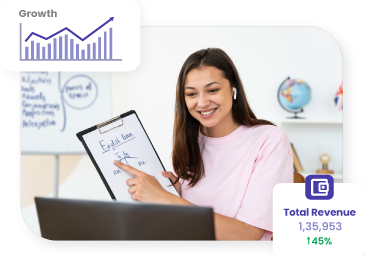Indian creators today have more opportunities than ever to turn their knowledge into income. Whether you’re a wellness coach helping clients transform, an educator building online courses, or a designer selling digital assets, your work has value, and people are willing to pay for it.
But how do you turn attention into action? Getting likes and compliments is great, but consistent sales? That’s a different game. Take Vidya, a wellness coach in Bangalore. Her ₹50,000 transformation program delivers real results, but attracting new clients each month is a constant uphill battle. Or Rohan, a graphic design educator with a ₹5,000 online course that students love—but sales trickle in, unpredictably.
For creators like them and maybe you, relying on word-of-mouth or random posts isn’t sustainable. You need a system that turns curious followers into committed buyers. That system is a lead generation sales funnel, and this guide will show you how to build one that works for your creator business.
Definition and Purpose of a Lead Generation Sales Funnel
A lead generation sales funnel is a simple system that guides someone from discovering you to eventually buying your digital product, whether it’s a course, coaching program, or workshop.
Think of it as a journey: at the top, lots of people are just finding out about you. As they move through each stage, learning more, engaging, and trusting you, some will drop off, but others will become paying clients. That’s why it’s called a funnel.
For creators, this funnel has four key roles:
- Attract: Bring in potential clients who are genuinely interested in what you teach or offer.
- Nurture: Build trust by sharing valuable content that helps them solve small problems or gain quick wins.
- Convert: Turn that interest into action. For example, getting them to sign up, book a session, or buy your course.
- Improve: Analyse each stage to see what’s working and where you’re losing people so that you can optimize it over time.
With the right funnel in place, your sales process becomes more predictable, less stressful, and far more effective. This helps you grow consistently without relying only on luck or last-minute launches.
Importance of Streamlining the Funnel for ROI
As a creator, your time is precious. You’re juggling content creation, community engagement, and the actual delivery of your digital products. A well-oiled sales funnel isn’t just about more sales; it’s about maximizing your impact and your return on the effort you invest. Here’s why streamlining your funnel is crucial:
- Higher Conversion Rates: Providing the correct information at the right time increases the likelihood of interested individuals becoming paying customers.
- Reduced Acquisition Costs: Instead of constantly chasing new leads, a funnel helps you nurture existing interest, making your marketing efforts more efficient and cost-effective.
- Deeper Audience Understanding: Analyzing your funnel reveals valuable insights into your audience’s behavior, allowing you to tailor your content and offers even more effectively.
- Predictable Income Growth: A well-functioning funnel provides a more reliable flow of customers, making your income more predictable and allowing you to plan for growth.
Think of Priya, a successful digital artist selling Procreate brush packs. By implementing a funnel, she moved from sporadic sales on marketplaces to consistent daily sales. This helped her directly engage with her audience through her platform and understand their creative needs better.
Optimizing your funnel means investing directly in the sustainable growth of your creator business. To understand the practical steps involved, let’s explore the key stages of your creator-focused lead generation sales funnel.
Also read: Understanding What is Lead Management: Definition, Tools, and Strategies
Key Stages of Your Creator-Focused Lead Generation Sales Funnel
While the specifics might vary based on your niche and the digital products you offer, these key stages form the foundation of a successful lead generation sales funnel for creators:
1. Awareness: Capturing Attention with Your Unique Value Proposition
At the top of your funnel, potential followers and customers first become aware of your existence and the value you offer. They might stumble upon your content on social media, find your blog through a search, or hear about you from a friend.
Your primary goal is to make a compelling first impression and offer something valuable enough to capture their interest.
Lead Magnets for Creators: This is where your expertise shines! Offer free, valuable resources in exchange for an email address or other contact information. Think about:
- For a Wellness Coach (Vidya): A free guide on “5 Simple Yoga Poses to Reduce Morning Stiffness” or a short video series on “Mindful Eating Habits.”
- For a Course Creator (Rohan): A free introductory module of his design course, a downloadable cheat sheet of essential design principles, or a short video tutorial on a specific design technique.
- For a Digital Artist (Priya): A free sample brush pack, a mini-tutorial on a specific artistic technique, or a downloadable set of color palettes.
- For a Content Creator: A checklist for creating engaging social media content, a template for brainstorming blog post ideas, or a short guide on the best tools for their niche.
The key is offering something directly relevant to your ideal customer’s needs that showcases your expertise.
2. Interest: Nurturing Curiosity and Demonstrating Your Expertise
Once you’ve captured their attention with a valuable lead magnet, the interest stage is about deepening their engagement. Provide content that educates, inspires, and demonstrates your unique perspective and the value of your broader offerings.
- Blog Posts: Share insights, tips, and behind-the-scenes glimpses related to your niche. For Vidya, this could be articles on managing stress through mindfulness; for Rohan, it could be discussions on design trends; for Priya, it might be articles on different artistic styles; and for a content creator, it could be posts on audience engagement strategies.
- Videos: Create engaging video content that resonates with your audience, such as tutorials, Q&A sessions, case studies of successful clients (if applicable), or personal stories.
- Email Newsletters: Regularly share valuable insights, updates on your new offerings, and exclusive content with your email subscribers. This is your direct line to nurturing relationships.
- Social Media: Share valuable tips, engage in conversations, and offer glimpses into your process and the transformations you help your audience achieve.
- Podcasts or Live Sessions: If applicable, these formats allow for deeper connections and the opportunity to answer questions directly.
3. Consideration: Showcasing the Transformation Your Digital Products Offer
At this stage, leads actively consider solutions to their problems and evaluate whether your digital products are the right fit. They’re looking for more in-depth information and social proof.
- Product Demos or Previews: Offer a sneak peek into your course content, coaching program structure, or digital product features. Rohan could walk through the first few lessons of his design course, and Vidya could show a sample session of her coaching program.
- Webinars or Workshops: Host live or recorded sessions that provide in-depth value and allow potential customers to experience your teaching style or expertise firsthand.
- Case Studies or Testimonials: Share stories of how your digital products have helped others achieve their goals. Authentic testimonials build trust and credibility.
- Comparison Guides: If relevant, you could create content that subtly highlights the unique benefits of your approach compared to other options.
- Free Trials or Limited Access: Offering a free trial for certain digital products (like memberships or software) can be a powerful way to demonstrate value.
4. Decision: Encouraging Investment in Your Expertise

Leads in this stage are ready to make a decision. Your goal is to make it easy for them to invest in your digital products by providing clear calls to action and addressing any remaining hesitations.
- Clear Calls to Action (CTAs): Use compelling language like “Enroll Now,” “Download Your Guide,” “Book a Discovery Call,” “Get Instant Access,” or “Unlock Your Transformation.” Make these CTAs visually prominent and easy to click.
- Limited-Time Offers or Bonuses: Offer special discounts or bonuses for a limited time to create a sense of urgency or added value.
- Payment Options and Guarantees: Provide various payment options to ensure a smooth and secure purchase process. Consider offering a satisfaction guarantee to reduce perceived risk.
- Personalized Consultations: For higher-priced offerings like coaching programs, offering a free discovery call can help address individual questions and build rapport.
5. Action: Celebrating the Purchase and Building a Community
This is the moment a lead becomes a customer. However, your journey with them doesn’t end here. The action stage provides an excellent onboarding experience and fosters a long-term relationship.
- Welcome and Onboarding: Provide clear instructions on accessing their purchased digital product and offer support.
- Excellent Customer Support: Be responsive to questions and provide helpful assistance.
- Community Building: Encourage interaction among your customers through private forums, social media groups, or live Q&A sessions. This fosters a sense of belonging and encourages repeat purchases.
- Feedback and Testimonial Requests: Encourage satisfied customers to share their experiences.
- Upselling and Cross-selling: Once customers have experienced the value of one of your digital products, they may be interested in other related offerings.
Now that we’ve mapped out the crucial stages of a creator-focused lead generation sales funnel, let’s dive into the actionable steps you can take to build your effective system.
Step-by-Step Guide to Building Your Lead Generation Sales Funnel
You’ve put in the work: created the course, launched the program, delivered real results. But despite all that, sales are inconsistent. A lead generation sales funnel helps you attract the right people, build trust, and guide them smoothly toward buying from you, without burning out or guessing what to do next.
In the steps below, you’ll learn exactly how to build a funnel that works for your creator business, whether you’re a coach, educator, or digital product seller, so you can stop chasing leads and start growing.
Step 1: Identify Target Customers
You can’t sell to everyone, and you don’t need to. The first step to building a successful lead generation funnel is getting super clear on who you’re speaking to.
1. Researching customer behaviors and pain points:
Look through your Instagram DMs, comments, workshop feedback, or coaching call notes. What questions keep coming up? What struggles do your best clients mention again and again? Pay attention to what content they save or reply to. That’s your goldmine.
2. Build a Realistic Profile of Your Ideal Client
Forget corporate-style buyer personas, just ask yourself:
- Who gets the best results from my program?
- What are they struggling with before they find me?
- What makes them finally say, “Yes, I need this”?
You can even run an Instagram Story poll or post a simple question like, “What’s the biggest thing holding you back from [insert transformation]?” Use those answers to shape your messaging and funnel.
When you know exactly who you’re helping, everything, from your landing pages to your content, starts working better.
For example, “Busy Bee Bhavna” could be a persona for Vidya, a 35-year-old working professional in Mumbai who wants to improve her energy levels and reduce stress but has limited time.
Step 2: Create Compelling Content
Content is the fuel that drives your sales funnel. It attracts leads, cultivates their interest, and nurtures them through the buying process.
1. Developing valuable content such as blogs, videos, and ebooks:
Develop a content strategy that aligns with your audience’s needs and interests. Utilize various content formats to cater to different preferences.
Blog posts are excellent for informing and addressing specific questions, while videos can be highly engaging for simplifying complex concepts and showcasing products. Ebooks offer in-depth guides, and infographics present data visually appealingly.
2. Ensuring content connects with each stage of the funnel:
Map your content to the sales funnel, aligning it with each stage of the funnel. Use blog posts, social media content, and infographics to capture attention for the awareness stage.
In the interest stage, leverage case studies, email newsletters, and explainer videos to build interest. For the consideration stage, provide product demos, comparison guides, and customer testimonials to support your product.
Finally, in the decision stage, offer deals, free trials, and personalized consultations to help customers make informed choices. Tailor your messaging to address the specific needs and concerns of leads at each stage of the sales process.
Step 3: Drive Traffic to Your Funnel
Creating compelling content is only part of the equation. You must also ensure that your target audience sees it. To capture leads effectively, drive traffic to your website or landing pages.
1. Strategies including SEO, organic search, and paid advertising:
Employ a combination of strategies to drive traffic. Search engine optimization (SEO) is crucial for improving your website and content’s visibility in search engine results. Optimize your site for relevant keywords to achieve higher rankings.
Organic search attracts visitors through unpaid search results, while paid advertising, using platforms like Google Ads, LinkedIn Ads, and Facebook Ads, allows you to reach a broader audience and drive targeted traffic to your funnel.
2. Using platforms like Google, LinkedIn, and Facebook:
Each platform offers unique advantages. Google Ads effectively reaches users actively searching for solutions, while LinkedIn Ads allows you to target professionals based on job title and industry. Facebook Ads can reach a broad audience and target users based on specific interests and behaviors.
Step 4: Engage Leads Effectively

After capturing leads, you must effectively engage them, nurture them through the funnel, build strong relationships, provide value, and guide them towards purchasing.
1. Utilizing email marketing for nurturing leads:
Email marketing remains a powerful tool for maintaining contact with leads. Deliver valuable content that aligns with their needs, promotes your products or services, and builds trust. Email marketing is highly targeted, allowing you to segment your lists and send personalized messages.
It is also cost-effective and offers a high return on investment. You can measure the effectiveness of your campaigns by tracking key metrics such as open rates, click-through rates, and conversions.
2. Segmenting leads and automating email campaigns:
Segment your leads based on criteria such as their characteristics, behavior, or stage in the sales funnel. Utilize email automation software to deliver the right message at the optimal time.
For example, you can create automated email sequences for leads who download an ebook or register for a webinar. Tailor your messaging to resonate with their specific interests and needs.
Step 5: Convert Leads into Customers
The ultimate goal of a lead generation sales funnel is to convert leads into paying customers. To achieve this, employ a tailored sales approach that addresses each lead’s unique needs.
1. Personalized Sales Conversations (Where Applicable):
For higher-value offerings like coaching programs, offer personalized discovery calls to understand individual needs and tailor your pitch.
2. Using demos, trials, and personalized offers to close sales:
Use practical tools and techniques to encourage purchase decisions. Product demos can showcase the features and benefits of your product, while free trials allow leads to experience its value firsthand.
Personalized offers tailored to the lead’s specific needs and budget can also be highly effective. For Rohan’s course launch, he might offer a discount for the first 50 enrollments or include a bonus set of design templates.
Read more: How to Create a Perfect Marketing Strategy
Furthermore, for creators looking for a comprehensive solution to handle all their lead generation and sales needs, there’s Exly.
Exly: Your All-in-One Platform for Lead Generation and Sales
Exly is a comprehensive platform designed to help businesses streamline their lead generation and sales processes. It offers a suite of tools to attract, engage, and convert leads, all in one centralized location.
Here’s why creators choose us:
- Website Builder: Enables the creation of high-converting landing pages.
- Marketing Suite: Provides email tools for targeted campaigns and lead nurturing.
- Social Media Management: Allows effective management of online presence, scheduling posts, and driving engagement.
- Content Management: Helps create valuable content that resonates with the target audience.
- CRM System: Tracks interactions with leads.
- Sales Tools: Automates the buying process with sales funnels.
- Checkout Pages: Increases conversions.
- Community Building features: Fosters brand loyalty.
- Monetization Tools: Facilitates direct sales of products, services, and courses.
Exly empowers creators like you to manage your entire sales funnel effectively, from attracting leads to converting them into loyal customers.
Conclusion
Building a successful lead generation sales funnel is no longer a luxury but necessary for creators who want to create sustainable and thriving businesses. By understanding each stage of the funnel and implementing creator-centric strategies, you can transform casual interest into consistent income from your digital products.
Remember, it’s not just about how many leads you attract; it’s about building genuine connections and confidently and clearly guiding the right people toward your offer.
If you’re ready to implement this strategy, Exly is here to help. From building high-converting landing pages to automating follow-ups and managing leads, Exly gives you everything you need in one place, built for creators like you.





